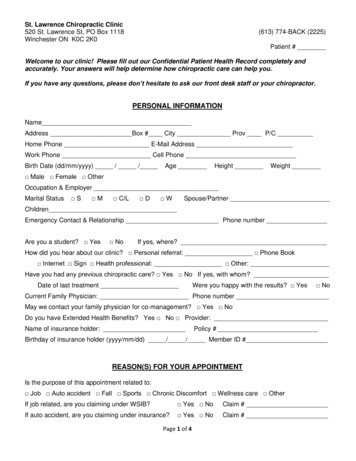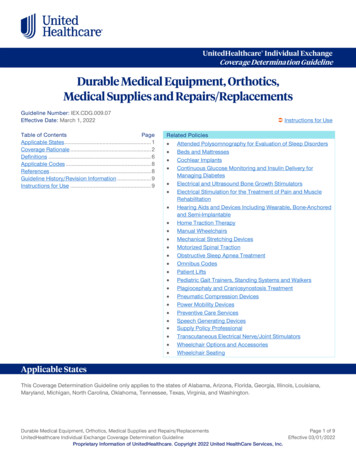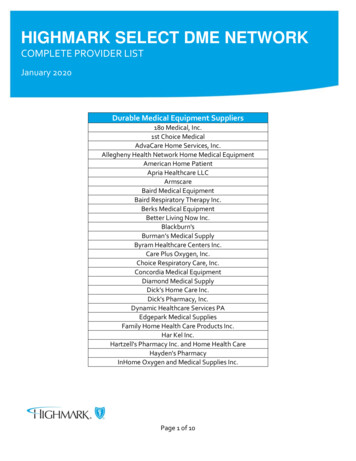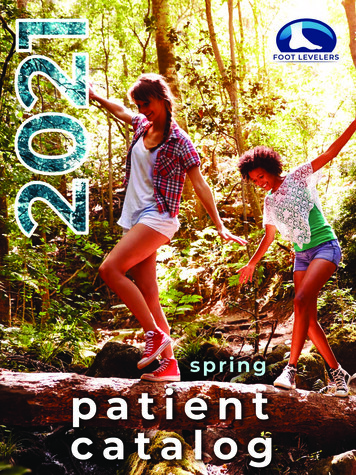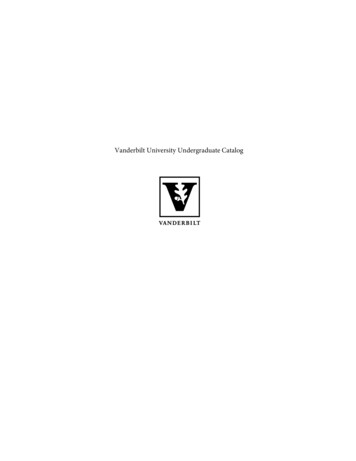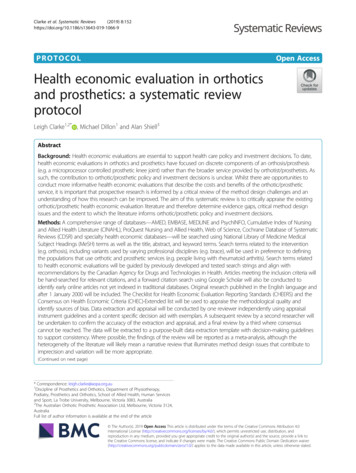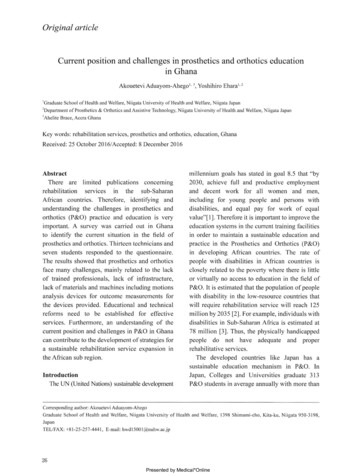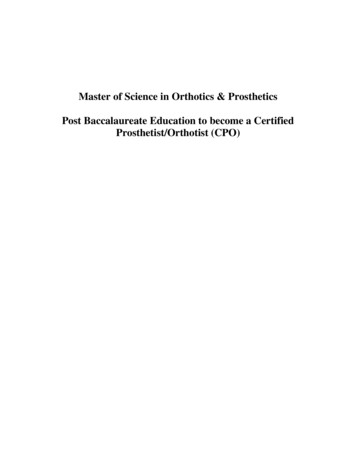
Transcription
Master of Science in Orthotics & ProstheticsPost Baccalaureate Education to become a CertifiedProsthetist/Orthotist (CPO)
Table of Contents:Introduction to the Profession2List of Accredited O & P School Programs3Prerequisite Courses4Additional Application Requirements8Links for Additional Info on O & P9Links for Each Individual O&P School10FAQs111
Master’s Degree in Orthotics & Prosthetics - Post Baccalaureate Education to become aCertified Prosthetist/Orthotist (CPO)Occupational Description:Orthotics and prosthetics are applied physical disciplines that address neuromuscular andstructural skeletal problems in the human body with a treatment process that includes evaluationand transfer of forces using orthoses and prostheses to achieve optimum function, prevent furtherdisability, and provide cosmesis. The orthotist and prosthetist work directly with the physicianand representatives of other allied health professions in the rehabilitation of the physicallychallenged. The orthotist designs and fits devices, known as orthoses, to provide care to patientswho have disabling conditions of the limbs and spine. The prosthetist designs and fits devices,known as prostheses, for patients who have partial or total absence of a limb.Job Description:The role of the orthotist and prosthetist includes, but may not be limited to, five major domains:clinical assessment, patient management, technical implementation, practice management, andprofessional responsibility.Employment Characteristics:Orthotists and prosthetists typically provide their services in one or more of the followingsettings: private facilities, hospitals and clinics, colleges and universities, and medical schools.Educational Programs:Length. Orthotic and/or prosthetic education culminates in a Master's degree.Prerequisites. Applicants should have a baccalaureate degree that includes appropriatecoursework in biology, chemistry, physics, psychology, algebra, human anatomy, andphysiology, as well as any other specified by the institution.Curriculum. The professional curriculum includes formal instruction in biomechanics gaitanalysis/pathomechanics, kinesiology, pathology, materials science, research methods,diagnostic imaging techniques, measurement, impression taking, model rectification, diagnosticfitting, definitive fitting, postoperative management, external power, static and dynamicalignment of sockets related to various amputation levels, and fitting and alignment of orthosesfor lower limb, upper limb, and spine with various systems to be included. The curriculum alsoincludes a clinical experience.**The description above is a direct quote from the Commission on Accreditation of AlliedHealth Education Programs and can be accessed at the following Orthotist-Prosthetist.aspx2
List of Accredited Schools for Master’s Degree in Orthotics and Prosthetics:Programs listed in alphabetical order by stateAlabama State College of Health Sciences (Montgomery, AL)California State University (Los Alamitos, CA)Loma Linda University School of Allied Health Professions (Loma Linda, CA)University of Hartford (West Hartford, CT)Florida International University (Miami, FL)**FIU’s program is a Master of Science in Engineering Management Orthotics andProsthetics, which differs from all other programs discussed in this packet. Refer to thisprogram’s website (Page 10) for more information, as requirements and education maydiffer from all other programs discussed here.Northwestern University (Chicago, IL)Eastern Michigan University (Ypsilanti, MI)Concordia University (St. Paul, MN)University of Pittsburgh (Pittsburgh, PA)Baylor College of Medicine (Houston, TX)University of Texas Southwestern Medical Center (Dallas, TX)University of Washington (Seattle, WA)**This packet is meant to provide a comprehensive look at each of the schools combined into asingle location for comparison. If you are interested in a specific program, the link for each islisted on the Page 10; more in depth information for each program can be found at thesewebsites.3
Prerequisites Courses Required for all Programs:Baccalaureate degree from an accredited US college or university or an internationallyrecognized equivalent with a minimum cumulative GPA of 3.0 on a 4-point scale, in addition tocompletion of the Graduate Record Examination (GRE). The following prerequisite courses arerequired by ALL programs in order to apply. A grade of “B” or higher must be achieved inprerequisite courses to be considered for most programs. (While a few programs will allow agrade of a “C” or higher in prerequisite courses, it is recognized that competitive applicants willachieve a grade of a “B” or higher.)Course NameCredit HoursBiology/Life Sciences with Lab4Chemistry with Lab4Physics I with Lab4Human Anatomy with Lab ANDHuman Physiology with Lab8Psychology3Statistics3College Algebra or higher math*3Many programs require additional prerequisite courses, which are listed by school on thefollowing page. Additional requirements for applying can be found on Page 8.**The courses listed above and on the following 3 pages are based on information from eachprogram’s individual website; however, this information has the potential to change. Confirmingthese courses by reviewing individual programs’ websites is advised. Updated 04/20204
Additional Prerequisite Courses Required by some Programs:Course (minimum credit hours)Alabama State College of Health SciencesDevelopmental Psychology (3) OR Abnormal Psychology (3) Encouraged but not required: Physics II with Lab, Math beyond College AlgebraCalifornia State UniversityHuman Growth and Development (3) OR Abnormal Psychology (3) Encouraged but not required: Ethics, Business ManagementLoma Linda University School of Allied Health ProfessionsDevelopmental Psychology (3) OR Abnormal Psychology (3)CPR Course & Certification (required before clinical rotations, recommended prior to program start)University of HartfordHuman Growth and Development (3)Abnormal Psychology (3)Physics II with Lab (4)College Trigonometry (3)Northwestern University Encouraged but not required: Business Management, Material Science, ComputerScience, Developmental or Abnormal Psychology,Eastern Michigan UniversityAdditional Psychology course (3)College Trigonometry (3)University of PittsburghHuman Growth and Development (3) OR Abnormal Psychology (3) Science courses may NOT be completed in an online or e-learning settingBaylor College of Medicine Encouraged but not required: Engineering courses (Biomechanics, Materials Science)University of Texas Southwestern Medical CenterPhysics II with Lab (4)Additional Biology Course with Lab (4)University of WashingtonDevelopmental Psychology (3) OR Abnormal Psychology (3)Physics II with Lab (4)**The courses listed above and on the following two pages are based on information from eachprogram’s individual website; however, this information has the potential to change. Confirmingthese courses by reviewing individual programs’ websites (found on Page 10) is advised.5
6Los Alamitos, CABiology/Life Scienceswith Lab (4)Chemistry with Lab (4)Physics I with Lab (4)Human Anatomy withLab (4)Human Physiology withLab (4)Psychology (3)Statistics (3)College Algebra (3) orhigher mathMontgomery, ALBiology/Life Scienceswith Lab (4)Chemistry with Lab (4)Physics I with Lab (4)Human Anatomy withLab (4)Human Physiology withLab (4)Psychology (3)Statistics (3)College Algebra (3) orhigher mathCollege Algebra (3) orhigher mathStatistics (3)Psychology (3)Human Physiology withLab (4)Human Anatomy withLab (4)Physics I with Lab (4)Chemistry with Lab (4)Biology/Life Scienceswith Lab (4)Loma Linda, CAPhysics II with LabMath Beyond CollegeAlgebraBusiness ManagementEthicsStatistics (3)Psychology (3)Human Physiology withLab (4)Human Anatomy withLab (4)Physics I with Lab (4)Chemistry with Lab (4)Biology/Life Scienceswith Lab (4)Miami, FLBelow courses encouraged, but not required:CPR Course &Abnormal Psychology (3) (See individual programCertification (required beforewebsite for details, asclinical rotations, recommendedPhysics II with Lab (4)requirements may vary)prior to beginning program)**This is a Master ofScience in EngineeringManagement O & PDevelopmental orAbnormal PsychologyBusiness ManagementMaterials ScienceComputer ScienceCollege Algebra (3) orhigher mathStatistics (3)Psychology (3)Human Physiology withLab (4)Human Anatomy withLab (4)Physics I with Lab (4)Chemistry with Lab (4)Biology/Life Scienceswith Lab (4)Chicago, ILFlorida InternationalNorthwestern UniversityUniversityCollege Trigonometry (3) College Algebra (3) orhigher mathStatistics (3)Psychology (3)Human Physiology withLab (4)Human Anatomy withLab (4)Physics I with Lab (4)Chemistry with Lab (4)Biology/Life Scienceswith Lab (4)West Hartford, CTLoma Linda UniversitySchool of Allied Health University of HartfordProfessionsDevelopmentalHuman Growth &DevelopmentalHuman Growth &Psychology (3) ORDevelopment (3) ORPsychology (3) ORAbnormal Psychology (3) Abnormal Psychology (3) Abnormal Psychology (3) Development (3)California StateUniversityAlabama State Collegeof Health Sciences
7Human Physiology withLab (4)Psychology (3)Statistics (3)Human Physiology withLab (4)Psychology (3)Statistics (3)Statistics (3)Psychology (3)Human Physiology withLab (4)Human Anatomy withLab (4)College Algebra (3) orhigher mathStatistics (3)Psychology (3)Human Physiology withLab (4)Human Anatomy withLab (4)Physics I with Lab (4)Chemistry with Lab (4)(Biomechanics, MaterialScience, etc.)Engineering coursesBelow courses encouraged, but not required:Science courses may NOTbe taken in online settingsHuman Growth &Development (3) ORAbnormal Psychology (3)Human Anatomy withLab (4)Human Anatomy withLab (4)Physics I with Lab (4)Additional Psychologycourse (3)Physics I with Lab (4)Physics I with Lab (4)Chemistry with Lab (4)College Algebra (3) orhigher mathChemistry with Lab (4)Chemistry with Lab (4)Biology/Life Scienceswith Lab (4)Houston, TXPittsburgh, PABiology/Life Scienceswith Lab (4)Baylor College ofMedicineUniversity of PittsburghCollege Trigonometry (3) College Algebra (3) orhigher mathBiology/Life Scienceswith Lab (4)St. Paul, MNYpsilanti, MIBiology/Life Scienceswith Lab (4)Concordia UniversityEastern MichiganUniversityPhysics II with Lab (4)Additional BiologyCourse with Lab (4)College Algebra (3) orhigher mathStatistics (3)Psychology (3)Human Physiology withLab (4)Human Anatomy withLab (4)Physics I with Lab (4)Chemistry with Lab (4)Biology/Life Scienceswith Lab (4)Dallas, TXUniversity of TexasSouthwestern MedicalCenterPhysics II with Lab (4)DevelopmentalPsychology (3) ORAbnormal Psychology (3)College Algebra (3) orhigher mathStatistics (3)Psychology (3)Human Physiology withLab (4)Human Anatomy withLab (4)Physics I with Lab (4)Chemistry with Lab (4)Biology/Life Scienceswith Lab (4)Seattle, WAUniversity ofWashington
Additional Requirements:Applications are submitted via Orthotics and Prosthetics Centralized Application Service(OPCAS). Requirements for ALL programs include:3 letters of recommendation - at least 1 must be from a Prosthetist/OrthotistBackground checkImmunizationsPersonal StatementGraduate Record Exam (GRE) - taken within 5 years of applyingAdditionally, ALL programs highly recommend documented job shadowing, volunteering,interning, and/or working with prosthetics/orthotics at a clinic/institution for as many hours aspossible to gain experience in the profession. Programs are limited to accepting 10-30 studentseach year, so it is expected that applicants have knowledge about the profession in order toensure commitment to completion of the program.The following programs require a specified minimum number of hours of documentedexperience within the profession upon applying:Program NameHoursAlabama State University100California State University40Loma Linda UniversitySchool of Allied HealthProfessions80University of Pittsburgh250Baylor College of Medicine150**Additional requirements may be requested during the application process. Information can befound at individual programs’ websites (found on Page 11 of this packet), and through theOrthotics and Prosthetics Centralized Application Service (OPCAS) Portal, which can beaccessed at the following ogin8
Links for Additional Information on Orthotics & Prosthetics:National Commission on Orthotic and Prosthetic Education (NCOPE)https://ncope.org/NCOPE: “Our Profession” Career -profession/Orthotics and Prosthetics Centralized Application Service (OPCAS) loginThe American Academy of Orthotists and Prosthetistshttps://www.oandp.org/9
Links for Additional Information by Program:Alabama State College of Health orthotics/application-informationCalifornia State ndp/msop-option/Loma Linda University School of Allied Health orthotics-and-prosthetics/admissions-opUniversity of orida International UniversityMaster of Science in Engineering Management Orthotics and hetics/Northwestern tion/masters-program/admissions.htmlEastern Michigan Universityhttps://catalog.emich.edu/preview program.php?catoid 33&poid 13894Concordia ty of ylor College of ty of Texas Southwestern Medical otics/admissions/University of gree/po/eligibility.asp**All information listed has been obtained from the websites above and has in many cases beensummarized for simplicity. As information can be subject to change, confirming informationfound in this packet with the websites above is advised.Updated: 04/2020.10
Frequently Asked Questions:What is a CPO?A CPO is a Certified Prosthetist and Orthotist. This is the title of a clinician/practitionerwho has passed the national board examinations following completion of a Master ofScience in Orthotics & Prosthetics and Clinical Residency.As a prosthetist, do you work with patients or make the devices?Both. Prosthetic care consists of patient evaluation, and design, fabrication, and customfitting of prosthetic devices (prostheses) to restore function to a part of the body.Additional information on the role of a prosthetist can be found on Page 2 and Page 9.What does an orthotist do?Orthotic care consists of patient evaluation, and design, fabrication, and custom fitting oforthopedic braces (orthoses) in order to control motion, assist motion, reduce pressures,aid healing, reshape, or restore function to a part of the body. Additional information onthe role of an orthotist can be found on Page 2 and Page 9.Where do Orthotists/Prosthetists work, and what types of jobs can you get?Hospitals, VA Hospitals and Clinics, Private Clinics and Clinical Groups, Humanitarian,Clinical Education, Manufacturing/Product Development, Research, EntrepreneurshipProsthesis and Orthosis vs. Prosthetic and Orthotic?Prosthetic and Orthotic are adjectives (i.e. a prosthetic leg, an orthotic design)Prosthesis and Orthosis are nouns (i.e. his/her prosthesis, his/her orthosis)How do you become an Orthotist/Prosthetist?Bachelor’s degree (with required prerequisites)Master’s degree in Orthotics & Prosthetics (18-24 months)Clinical Residency (12 months Orthotics AND 12 months Prosthetics;OR 18 months Integrated Orthotics and Prosthetics)Board Eligibility upon graduation and completion of residency5 national board examinations for certification in Orthotics and ProstheticsWhat should I major in if I want to become an Orthotist/Prosthetist?Like many other health professions, there is no single major recommended, just requiredprerequisites. Common degrees include Health Sciences and EngineeringWhat careers exist in Orthotics and Prosthetics other than an Orthotist/Prosthetist?Other careers in Orthotics & Prosthetics include fitters, technicians, and assistants; moreinformation about each of these careers can be found on Page 9, and at the following fession/Additionally, Orthotists/Prosthetists frequently work in collaboration with physical andoccupational therapists, who also provide care to patients with prostheses and/or orthoses11
coursework in biology, chemistry, physics, psychology, algebra, human anatomy, and physiology, as well as any other specified by the institution. Curriculum. . **FIU's program is a Master of Science in Engineering Management Orthotics and Prosthetics, which differs from all other programs discussed in this packet. Refer to this
